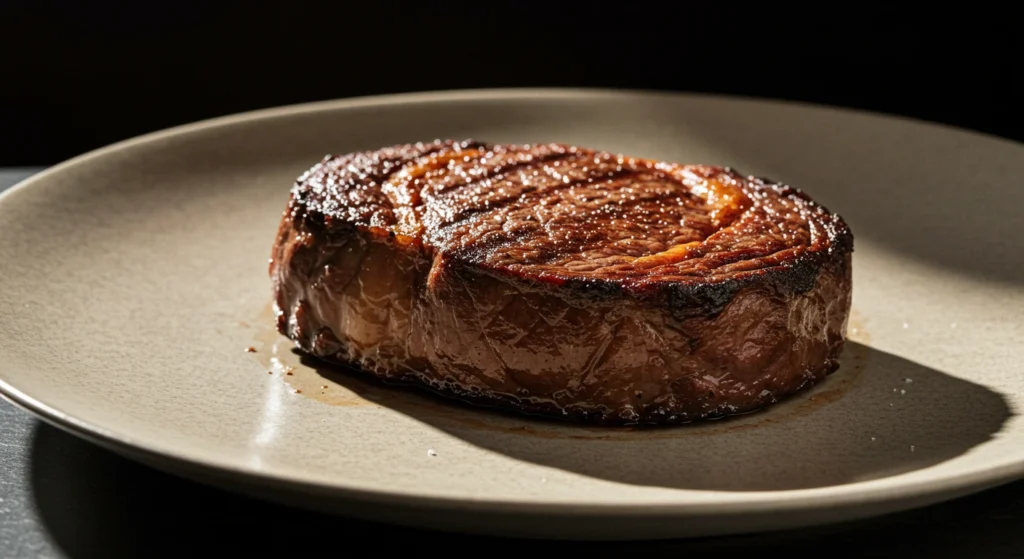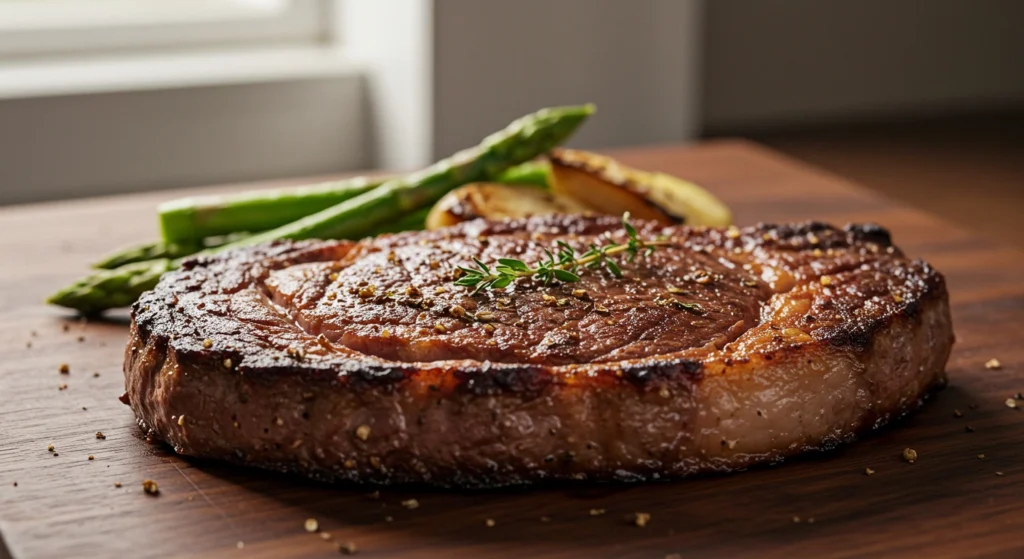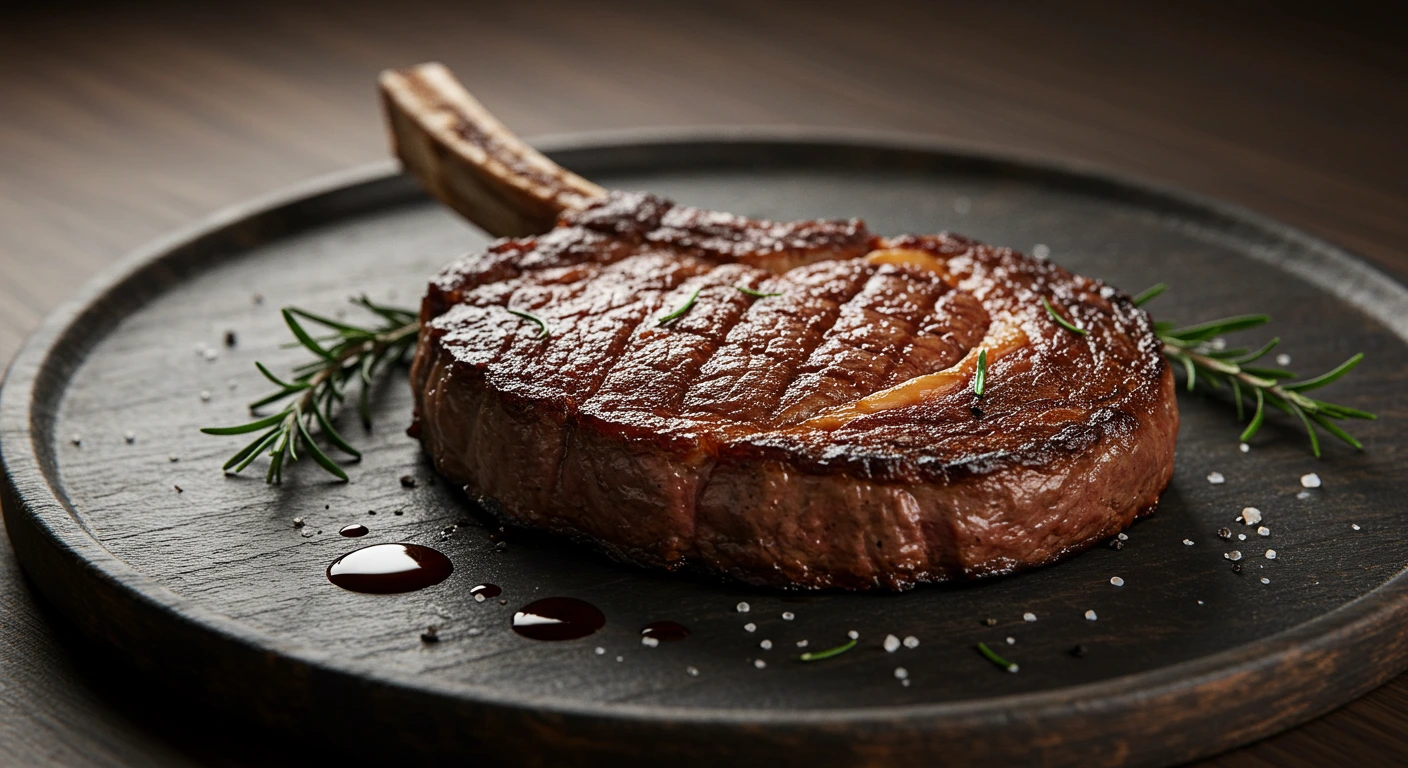Looking to simplify your diet, cut out carbs, and fuel your body with real, satisfying meals? The carnivore diet might be exactly what you’re searching for. Built on the principle of eating only animal-based foods, this approach emphasizes nutrient density, high protein, and healthy fats—no plants, no sugars, no processed foods. But if you’re worried that means boring meals, think again. There are many delicious carnivore diet steak recipes to keep your meals exciting.
With the right approach, carnivore diet recipes can be anything but bland. From perfectly seared steaks and crispy chicken thighs to rich bone broths and slow-roasted lamb, the options are as delicious as they are nourishing. Whether you’re in it for better digestion, improved energy, or sustainable weight loss, eating meat doesn’t have to mean eating the same thing every day.
This guide is here to help you master the basics and beyond. We’ll cover the best cuts of meat to use, what animal-based extras can enhance your meals, and of course, share a variety of easy, satisfying carnivore recipes that prove you don’t need carbs to enjoy food—or to feel amazing.
So if you’re ready to ditch the guesswork, fuel your body right, and stay fit with meals that actually taste good, let’s dive into the ultimate carnivore diet recipe guide that’s perfect for beginners, seasoned meat-lovers, and everyone in between.
Why Choose the Carnivore Diet?
The Science Behind Eating Only Animal-Based Foods
At first glance, the carnivore diet might seem a bit extreme, but once you take a closer look at the science behind this meat-based lifestyle, it starts to make much more sense. The carnivore diet is centered around eating only animal-based foods, which are rich in complete proteins, essential fats, and highly bioavailable nutrients. Unlike many plant-based diets, a carnivore-style eating plan eliminates plant compounds that may trigger inflammation or digestive issues for some individuals. In short, the carnivore way of eating offers a straightforward approach to nourishment—and it’s worth understanding why it works so well for so many.
Animal Foods Offer Complete Nutrition
Unlike most plant foods, animal products contain all the essential amino acids your body needs to build and repair tissues. They’re also rich in bioavailable nutrients, meaning your body absorbs them more easily. These include vitamins like B12, A, D, and K2, as well as important minerals such as iron, zinc, and calcium.
In addition, animal fat provides a steady, slow-burning energy source without causing blood sugar spikes. For many people, switching to a carnivore diet means better mental clarity, more stable energy throughout the day, and fewer cravings.
What Happens When You Ditch the Plants
Many plant foods contain natural defence chemicals, like oxalates, lectins, and phytates, that can irritate the gut or block nutrient absorption in some people. When you remove these from your diet and focus only on animal-based foods, it often leads to improved digestion, less bloating, and even reduced inflammation.
Also, the carnivore diet naturally eliminates sugar and ultra-processed carbs, which helps regulate insulin levels. This is why many people report weight loss, clearer skin, and fewer mood swings after just a few weeks of eating this way.
Benefits Backed by Science and Experience
Thousands of people have turned to the carnivore diet not only for simplicity but also because of the life-changing benefits it offers. From weight loss and mental clarity to better digestion and reduced inflammation, this way of eating has gained popularity both through scientific support and personal success stories.
Mental and Physical Clarity
One of the first things many people notice when switching to an animal-based diet is how much better they feel, physically and mentally.
That’s no coincidence. Removing processed carbs and sugar can help stabilize your blood sugar levels, which in turn supports consistent energy and focus throughout the day. Without those highs and crashes, it’s easier to stay alert, think clearly, and feel emotionally balanced.
Many reports:
- Sharper concentration and memory
- Fewer mood swings
- Reduced brain fog
Fat Loss, Digestion, and Inflammation
The carnivore diet naturally leads to fat loss for many people, mainly because it cuts out processed foods and triggers satiety through high protein and fat intake. When you’re full and nourished, you’re less likely to overeat.
At the same time, eliminating plant compounds—like lectins or oxalates—can reduce gut irritation and bloating. That’s why so many people with IBS, autoimmune issues, or sensitive digestion find relief on a carnivore diet.
Other commonly reported benefits include:
- Easier fat loss without calorie counting
- Stronger digestion and reduced bloating
- Less joint pain or inflammation
While results vary, the combination of real food, nutrient density, and metabolic support explains why so many find long-term success with carnivore. The science is compelling, and the real-life transformations are even more powerful.
Is It Right for You?
While the carnivore diet has helped many people transform their health, it’s important to know if it’s the right fit for your body, goals, and lifestyle. Like any way of eating, it’s not one-size-fits-all. But for many, it offers a powerful reset, especially if other diets haven’t worked.
Who May Benefit Most
The carnivore diet can be a game-changer for those dealing with chronic health issues, food sensitivities, or metabolic concerns. Because it removes common dietary triggers, it often brings fast relief.
You might consider trying it if:
- You struggle with bloating, IBS, or other gut issues
- You’ve hit a weight loss plateau despite dieting
- You have autoimmune conditions and want to reduce inflammation
- You feel better eating fewer carbs, or you already follow keto or low-carb
It’s also great for people who want simple meal prep and fewer decisions around food. With carnivore, what you eat becomes straightforward—meat, salt, water, repeat.
When to Use Caution
Although many people thrive on this way of eating, it’s not ideal for everyone. If you have certain medical conditions or are pregnant or breastfeeding, it’s always a good idea to check with a doctor or nutritionist before making major dietary changes.
Additionally, if you’re used to a high-carb or plant-based diet, transitioning to carnivore can come with an adjustment phase—sometimes called the “keto flu.” During this time, your body may need time to adapt to burning fat instead of carbs.
To stay safe and supported, consider:
- Tracking how your body feels during the first few weeks
- Adding electrolytes to avoid fatigue or cramps
- Starting with a more flexible version (e.g., including eggs and dairy)
The bottom line? The carnivore diet isn’t just for hardcore health enthusiasts—it’s for anyone who wants to simplify eating and get back in tune with their body. Just listen to your own signals and go at a pace that feels right for you.
Must-Have Carnivore Ingredients for Easy Recipes

Meats That Make It Work
The carnivore diet revolves around one main food group—meat—but that doesn’t mean every cut is the same. Choosing the right types of meat can make a big difference in how satisfied you feel, how much energy you have, and how well your body functions. From fatty steaks to nutrient-dense organ meats, variety is key to getting the most from this way of eating.
Fatty Cuts Keep You Satisfied and Fueled
Since you’re no longer getting energy from carbs, your body relies on fat for fuel. That’s why choosing meats with a good fat-to-protein ratio is so important on the carnivore diet. Fat keeps you full longer and helps maintain steady energy throughout the day.
Some of the best fatty cuts to include are:
- Ribeye steak – well-marbled and rich in both flavor and fat
- Ground beef (70/30 or 80/20) – budget-friendly and great for daily meals
- Pork belly or bacon – high in fat, especially useful when paired with lean meats
- Chicken thighs (with skin) – tastier and more satisfying than leaner chicken breast
These cuts help you feel fuller longer and make it easier to meet your daily calorie and fat needs without adding anything extra.
Nutrient-Dense Meats Support Full-Body Health
While fat and protein are your daily staples, variety is what brings balance. Including different types of meat ensures you’re covering all your bases when it comes to micronutrients. Organ meats, in particular, are like nature’s multivitamin.
Consider adding:
- Beef liver – rich in vitamin A, iron, and B12
- Heart – a great source of CoQ10 and zinc
- Lamb – nutrient-dense and a flavorful break from beef
- Bone-in cuts (like oxtail or short ribs) – perfect for slow cooking and collagen support
Rotating your meat choices adds flavor, improves nutrient intake, and helps prevent boredom—making the carnivore lifestyle easier to stick with long term.
Fats & Extras That Support Satiety
While protein often gets most of the spotlight on the carnivore diet, fat is just as essential, especially when you’re not eating carbs. Fat keeps you full, helps your hormones stay balanced, and provides the steady energy your body needs to thrive on a zero-carb lifestyle. And the best part? There are plenty of easy and delicious ways to add more of it to your meals.
Why Fat Matters on the Carnivore Diet
When you remove carbohydrates from your diet, your body shifts to using fat as its primary fuel source. This process, known as ketosis, helps stabilize blood sugar levels and reduces the energy crashes many people feel on high-carb diets. But to make this work, you need to get enough fat from your food.
Fat also plays a major role in satiety. It slows digestion, which means you feel satisfied longer after meals—and you’re less likely to snack or overeat later. That’s a huge benefit when trying to maintain or lose weight.
Some great sources of animal fat include:
- Beef tallow – great for cooking and adds richness to any dish
- Butter (or ghee) – perfect for pan-searing meats or topping steaks
- Fatty cuts of meat – like ribeye, pork belly, or lamb shoulder
- Egg yolks – a compact source of fat and essential nutrients
Add-Ons That Help You Thrive
Depending on how strict your version of the carnivore diet is, there are a few animal-based extras you can include that make meals more enjoyable without going off-plan. These additions offer both flavor and nutritional support.
Some optional extras to consider:
- Bone broth – great for hydration, gut health, and joint support
- Heavy cream – used in coffee or sauces for those who tolerate dairy
- Cheese – another fat-rich option for flexible carnivores
- Eggs – versatile and packed with fat-soluble vitamins
These extras not only boost fat intake but also help add texture and variety to your meals. For many carnivore dieters, they make the difference between just sticking with it and actually enjoying the process. In the end, fat isn’t just allowed on the carnivore diet—it’s essential. By embracing healthy animal fats and adding in a few nourishing extras, you’ll feel full, energized, and satisfied after every meal.
Recipes for Meal Prep & Batch Cooking
One of the biggest advantages of the carnivore diet is its simplicity, especially when it comes to meal prep. With just a few quality ingredients and a little planning, you can prepare a week’s worth of protein-rich, zero-carb meals that are easy to reheat and satisfy you all day long.
Whether you’re cooking for yourself, feeding a family, or just want to make healthy eating effortless during a busy week, these meal prep-friendly carnivore recipes are designed to save time without sacrificing flavor.
Batch-Friendly Basics
These are the go-to recipes you can prepare in bulk, store easily, and enjoy all week long.
- Slow-Cooked Chuck Roast: Toss a fatty beef roast in the slow cooker with salt and cook on low for 6–8 hours. The result is tender, shredded beef that stores well and reheats beautifully.
- Ground Beef “Carnivore Muffins”: Mix ground beef with egg, salt, and a bit of bone marrow or butter. Bake in muffin tins for easy, grab-and-go portions.
- Crispy Chicken Thighs: Bake or air fry a tray of chicken thighs with skin on for crisp texture and juicy flavor. These reheat well and are perfect for lunch boxes or quick dinners.
Time-Saving Tips for Cooking in Batches
Meal prepping doesn’t have to mean spending hours in the kitchen. With a few small strategies, you can maximize efficiency and minimize time spent cooking.
- Cook large portions in slow cookers or Instant Pots—they do the work for you.
- Use sheet pans to cook multiple pieces of meat at once.
- Portion your meals into glass containers right after cooking for quick grab-and-go options.
- Freeze extra servings of cooked meat to rotate variety throughout the week.
Batch cooking also ensures you always have a carnivore-friendly meal on hand, which makes it easier to avoid reaching for processed foods or off-plan ingredients when hunger hits.
Store, Reheat, and Enjoy
Once your meals are cooked and portioned, keeping them fresh is key. Store your meats in airtight containers in the fridge for up to 4 days, or freeze individual servings for longer storage. When it’s time to eat, reheat gently in a skillet or toaster oven to preserve flavor and texture.
Having your meals ready to go doesn’t just save time—it also removes decision fatigue and helps you stay consistent on your carnivore journey.
Tips for Long-Term Success on the Carnivore Diet

How to Stay Motivated
Like any lifestyle change, sticking with the carnivore diet long-term takes motivation, especially in the beginning. While the simplicity of meat-only meals is part of the appeal, staying consistent day after day requires a few mindset shifts and practical strategies. The good news? Once you start feeling the benefits, motivation becomes much easier to maintain.
Set Clear Goals and Track Progress
One of the best ways to stay motivated is by knowing why you started. Whether it’s weight loss, clearer skin, better energy, or healing from chronic issues, remind yourself of your goals regularly.
Writing them down or snapping weekly progress photos can help you see and feel your results, even when daily changes feel subtle.
Consider these simple motivation boosters:
- Keep a food and symptom journal to track how your body responds
- Set short-term goals (like 30 30-day strict carnivore)
- Take before-and-after photos every 2 weeks
- Measure progress by energy, sleep, and digestion, not just the scale
These tools help you connect the effort with the results, which can keep you focused and excited to keep going.
Add Variety and Build Support
Even though the diet is simple, eating the same cut of meat every day can get repetitive. So, switch things up! Rotating between beef, lamb, pork, and organ meats not only improves nutrition but also keeps meals enjoyable.
At the same time, building a support system makes a huge difference. Surrounding yourself with like-minded people—even online—can help you stay encouraged, especially during tough days.
Try:
- Joining carnivore or zero-carb communities on Reddit or Facebook
- Following motivational content creators on YouTube or Instagram
- Sharing your progress with a friend or accountability partner
- Rewarding yourself with non-food goals (like new kitchen gear or a self-care day)
Staying connected and adding small changes along the way will keep things fresh and keep you moving forward.
Common Challenges and How to Overcome Them
No diet is without its bumps in the road, and the carnivore diet is no exception. While it’s simple in concept, it can feel restrictive or overwhelming at times, especially when you’re first getting started. The key to success is recognizing these challenges early and knowing how to work through them with confidence and ease.
Adjusting to the First Few Weeks
The transition to an all-meat diet can be a shock to your system, especially if you’re coming from a high-carb or plant-heavy eating style. During the first week or two, many people experience symptoms often referred to as the “keto flu.” These symptoms are temporary but can be discouraging if you’re not prepared.
Here’s how to make the adjustment phase easier:
- Stay hydrated and add electrolytes (especially sodium, potassium, and magnesium)
- Eat enough fat to avoid energy crashes and cravings
- Rest more if you feel sluggish—your body is adapting
- Remind yourself that this is normal and usually passes in a week or two
Knowing what to expect helps you push through those early days with patience and trust in the process.
Social Pressure, Cravings, and Dining Out
Another common challenge? Social settings. Whether it’s dinner with friends, a holiday meal, or pressure from family, sticking to the carnivore diet in public can be tricky. You might also face cravings for carbs or sweets, especially if you’re used to snacking or emotional eating.
Fortunately, there are practical ways to handle it:
- Plan ahead when eating out—choose restaurants with simple meat options
- Be honest, but don’t over-explain your diet choices if you don’t want to
- Bring your own food to events when needed
- Have go-to meals ready at home so you don’t give in to cravings
Over time, your cravings will fade, and your confidence in your choices will grow. You’ll also find that your results speak for themselves, which makes saying “no thanks” a lot easier. Every lifestyle change comes with challenges, but overcoming them is what leads to long-term success. With the right mindset, preparation, and support, you can face these obstacles and stay on track with your carnivore journey—one satisfying meal at a time.
Maintaining Fitness and Energy Levels
One of the biggest concerns people have when starting the carnivore diet is whether they’ll still have the energy to stay active and keep up with workouts. The good news? With the right balance of fat, protein, and hydration, it’s entirely possible to build muscle, recover well, and feel strong—even without carbs.
Let’s break down how to support your body and keep your energy high.
Fueling Strength Without Carbs
Although traditional fitness advice often recommends carbs before workouts, the carnivore diet fuels your body differently. Once you’re adapted, your body becomes highly efficient at using fat for fuel, making energy steady and reliable.
To support workouts and recovery:
- Eat enough fat—it’s your new fuel source. Add tallow, butter, or fatty cuts to your meals.
- Prioritize protein—it supports muscle repair and growth.
- Time your meals around workouts if needed, especially post-training for recovery.
- Listen to your body—some days you may need more rest as you adjust.
Most carnivore athletes report more consistent energy and fewer crashes compared to high-carb diets—especially once they’ve fully adapted.
Staying Energized All Day Long
You don’t need pre-workout powders or energy drinks to feel your best on carnivore. Instead, staying energized comes down to proper nutrition, hydration, and recovery.
Here are some simple habits that help:
- Drink plenty of water and include electrolytes (like salt and potassium)
- Get enough sleep—your body needs it to rebuild and recharge
- Move daily, even if it’s just walking or light activity on rest days
- Eat when you’re hungry—don’t under-eat, especially if you’re active
As your body adjusts to using fat for fuel, you’ll likely notice that your energy stays more stable, without the ups and downs that come with sugar or carb-heavy meals.
If you’ve made it this far, you’re already one step closer to discovering just how simple and satisfying the carnivore lifestyle can be. With the right cuts of meat, a few go-to recipes, and a bit of planning, eating this way doesn’t just support your health—it actually makes mealtime something to look forward to.
Whether you’re in it for better energy, clearer skin, fat loss, or just the ease of fewer food decisions, the carnivore diet offers a refreshingly simple way to fuel your body with real, nourishing food. And the best part? You’re in full control—no counting, tracking, or complicated ingredients needed.
So go ahead—fire up the grill, batch-cook your favorites, and enjoy every bite. Because when you’re eating the foods your body loves, staying on track feels a lot less like a chore, and a lot more like freedom.
You’ve got this.

